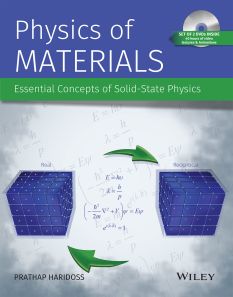Physics of Materials: Essential Concepts of Solid-State Physics
ISBN: 9788126557875
268 pages
Publication Year: 2015
eBook also available for institutional users
For more information write to us at: acadmktg@wiley.com

Description
This book examines essential concepts in Solid-State Physics. The accompanying DVD, containing 40 lectures of approximately an hour each, provides the student with the classroom experience. Animations are also included in the DVD to enable a more visual experience to understand the discussed concepts. Significant effort has been put in to present the material at the right level of detail such that it can be accessed and utilized by undergraduate and postgraduate students with a wide range of backgrounds. A conscious effort has been made to ensure that the level of detail used in the presentation enables students to stay with the content throughout.
Preface
Chapter 1 Introduction – Use and Study of Materials
1.1 Introduction
1.2 Materials and the Engineer
1.3 Materials and a Scientist
1.4 Modeling a Material
1.5 Approach Used in This Book
Chapter 2 Properties of Materials
2.1 Introduction
2.2 Mechanical Properties
2.3 Chemical Properties
2.4 Electrical Properties
2.5 Thermal Properties
2.6 Magnetic Properties
2.7 Optical Properties
2.8 Understanding Material Properties
Chapter 3 Thermal Expansion
3.1 Introduction
3.2 Use of Thermal Expansion / Contraction
3.3 Model for Thermal Expansion
Chapter 4 Electrical Conductivity
4.1 Introduction
4.2 Charge Carriers
4.3 Direct Current Conductivity Measurement
4.4 Alternating Current Conductivity Measurement
4.5 Short Note on Superconductivity
Chapter 5 Free Electron Gas and The Ideal Gas
5.1 Introduction
5.2 The Free Electron Gas
5.3 Packing Fraction in Solids
5.4 Reasons for Caution with the Free Electron Model
5.5 The Kinetic Theory of Gases
Chapter 6 The Drude Model
6.1 Introduction
6.2 Electrical Conductivity
6.3 Thermal Conductivity
6.4 The Wiedemann–Franz Law
6.5 Shortcomings of the Drude Model
Chapter 7 Large Systems, Statistical Mechanics and The Maxwell–Boltzmann Statistics
7.1 Introduction
7.2 Systems with Large Collections of Particles
7.3 Statistical Mechanics
7.4 The Maxwell–Boltzmann Statistics
Chapter 8 A Brief History of Quantum Mechanics; Its Use in the Drude–Sommerfeld Model
8.1 Introduction
8.2 Classical Particles and Quantum Mechanical Particles
8.3 A Brief History of Quantum Mechanics
8.4 The Drude–Sommerfeld Model
Chapter 9 Fermi–Dirac Statistics
9.1 Introduction
9.2 The Fermi–Dirac Statistics
9.3 Features of the Fermi–Dirac Distribution
9.4 Comparing Maxwell–Boltzmann and Fermi–Dirac Distributions
Chapter 10 Anisotropy, Periodic Potential, Confinement and Quantization
10.1 Introduction
10.2 Anisotropy in Crystalline Solids
10.3 Periodic Potential in a Crystalline Solid
10.4 Confinement and Quantization – Waves on a String Analogy
10.5 Confinement and Quantization – Quantum Mechanical Approach
Chapter 11 Density of States, Fermi Energy and The Electronic Contribution to Specific Heat at Constant Volume
11.1 Introduction
11.2 Density of States
11.3 Aspects Associated with Electrons Filling Energy Levels
11.4 Fermi Energy
11.5 Fermi Surface
11.6 Fermi Temperature
11.7 Estimating the Electronic Contribution to Specific Heat at Constant Volume
11.8 Further Improving the Model of the Solid
Chapter 12 The Reciprocal Space
12.1 Introduction
12.2 Defining Reciprocal Space
12.3 Properties of Reciprocal Space
12.4 Diffraction in Reciprocal Space
12.5 The Ewald Sphere
12.6 Crystal Lattices in Reciprocal Space
12.7 Reciprocal Lattice as the Fourier Transform of the Real Lattice
12.8 Another Way to Define or Describe Reciprocal Space
Chapter 13 Wigner–Seitz Cell, Brillouin Zones and The Origin of Bands
13.1 Introduction
13.2 The Wigner–Seitz Cell
13.3 The Brillouin Zone
13.4 Significance of Bragg Planes
13.5 Interaction of Electron Waves with Brillouin Zones
13.6 The Origin of Bands
Chapter 14 Bands, Band Gaps, Free Electron Approximation and Tight Binding Approximation
14.1 Introduction
14.2 Analytical Approach to The Band Structure – Free Electron Approximation
14.3 Band Structure and Types of Materials
14.4 Band Structure – The Tight Binding Approximation
14.5 Effect of Pressure on Band Structure
14.6 Comparison of Free Electron and Tight Binding Approximations
14.7 Conventions Regarding Representing Band Diagrams
Chapter 15 Material Phenomena Explained using Theories Developed
15.1 Introduction
15.2 Semiconductors
15.3 Types of Semiconductors
15.4 Effect of Temperature on Semiconductors
15.5 Optical Properties of Semiconductors
15.6 The Utility of E versus k Diagrams
15.7 Phonons
15.8 Magnetism
15.9 Electron Compounds
Chapter 16 Superconductivity and The Bose–Einstein Statistics
16.1 Introduction
16.2 Superconductivity
16.3 The Meissner Effect
16.4 The BCS Theory
16.5 The Bose–Einstein Statistics
16.6 The Bose–Einstein Condensate
Chapter 17 Physics of Nano-Scale Materials
17.1 Introduction
17.2 The Exciton
17.3 Confining the Exciton
Summary
Practice Questions
Answers
Bibliography
Index
"Core of a good materials engineer is built around a sound understanding of atomic structure of materials. Since electrons are the primary building blocks of atoms

